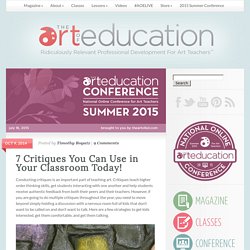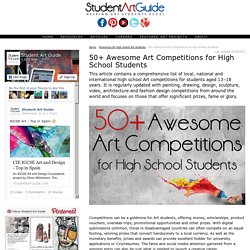

How to Conduct Socratic Seminars in the Art Room. For those who aren’t familiar with the concept, a Socratic Seminar is a classroom discussion that focuses on big ideas and involves all students.

It is basically the antithesis of a lecture–instead of transmitting knowledge from teacher to student(s), we are instead sharing our ideas through dialogue. Not debate, but dialogue. We are not covering a topic, or focusing on subject matter, we are exploring these things. We are not looking for right answers, and we are not looking to change anyone’s mind. We want to extend ideas, explore thoughts, and work collectively to think more deeply about those big ideas. Seminars are generally based on a text, and at times, we will use a text. Setting Up the Classroom Students should be set up in a circle. Setting Up the Discussion I will find an artwork to discuss that either has an ambiguous meaning, or a deep meaning that is worth discussing at length. 1. 2. 3. Conducting the Discussion Using the big idea, I will begin with an opening question. 10 Creative Critiques to Try This School Year.
Many of us might cringe thinking back to our days of college art critiques.

A poorly-facilitated critique can not only be a waste of time, but can also be disheartening for students. Many of us have been on the teacher side of things too, asking students to respond and engage and getting crickets in return. So, the question is, how can we make the critique process useful? Dare I say, enjoyable? I’d like to share some incredible critique activities to try in your room. Here are 10 Creative Critiques to Try This School Year.
7 Critiques You Can Use in Your Classroom Today! Conducting critiques is an important part of teaching art.

Critiques teach higher order thinking skills, get students interacting with one another and help students receive authentic feedback from both their peers and their teachers. However, if you are going to do multiple critiques throughout the year, you need to move beyond simply holding a discussion with a nervous room full of kids that don’t want to be called on and don’t want to talk. Here are a few strategies to get kids interested, get them comfortable, and get them talking. 1. The Sandwich Critique A LOT of teachers use this type of critique, and if you don’t, you should get on board!
50+ Awesome Art Competitions for High School Students. This article contains a comprehensive list of local, national and international high school Art competitions for students aged 13–18 years.

It is regularly updated with painting, drawing, design, sculpture, video, architecture and fashion design competitions from around the world and focuses on those that offer significant prizes, fame or glory. Competitions can be a goldmine for Art students, offering money, scholarships, product vouchers, overseas trips, promotional opportunities and other prizes. With digital submissions common, those in disadvantaged countries can often compete on an equal footing, winning prizes that convert handsomely to a local currency. As well as the monetary benefits, prizes and awards can provide excellent fodder for university applications or CVs/resumes. The fame and social media attention garnered from a winning entry can also be just what is needed to launch a creative career. CASE STUDY: Shania McDonagh, from Mount St. Feel the fear and do it anyway. Inside out project. For Teachers - Library of Congress. The Library of Congress Teaching with Primary Sources program provides primary source-based staff development to teachers across the country.

Free Easy to useStandards-basedAppropriate for all educators Build and Deliver Download and facilitate ready-to-present professional development modules from the Library's groundbreaking delivery system. All content is aligned to NSDC, AASL and ISTE national standards. Ideal for: Staff DevelopersContent ChairsSchool Library Media SpecialistsFacilitators Take Online Modules Complete an interactive self-directed module from the Library of Congress. Each multimedia-rich module delivers approximately one hour of professional development and includes a certificate of completion. TeachersLibrariansAdministratorsFacilitators Train with the Library of Congress Experts from the Library of Congress work directly with small groups of educators using material from the Library's Teaching with Primary Sources professional development program. Work with Our Partners.
The Helpful Art Teacher. ARTSEDGE: The Kennedy Center's Arts Education Network. TeachThought - Learn better. Asia Region Art Educators - Art educators living, working or interested in Asia. 12 Tools for Making Classroom Posters From edshelf.